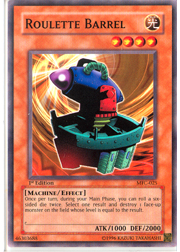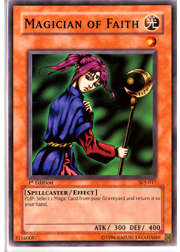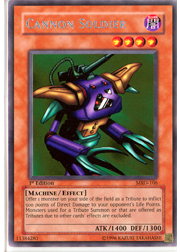

|
Doomkaiser Dragon
Card# CSOC-EN043


Doomkaiser Dragon's effect isn't just for Zombie World duelists: remember that its effect can swipe copies of Plaguespreader Zombie, too!
Click here for more
|
|
|

|
|
|

|
|
 |
 |
  |
| Deck Profiles |
| Jason Grabher-Meyer |
| July 27, 2004 |
|
|
| |
 Much to my happy surprise, the Canadian Yu-Gi-Oh! National Championships saw a lot of really interesting and creative decks being run, and successfully at that! I knew on Friday that we were in for a ride, for better or for worse, as tables were swarming with Roulette Barrel, Direct Damage decks, Magician of Faith, and other unconventional but perfectly legitimate card and deck choices. I was thrilled to see that as the event went on, innovative choices not nearly as common in most metagames of the U.S. made some serious positive impact on the tournament as a whole. Much to my happy surprise, the Canadian Yu-Gi-Oh! National Championships saw a lot of really interesting and creative decks being run, and successfully at that! I knew on Friday that we were in for a ride, for better or for worse, as tables were swarming with Roulette Barrel, Direct Damage decks, Magician of Faith, and other unconventional but perfectly legitimate card and deck choices. I was thrilled to see that as the event went on, innovative choices not nearly as common in most metagames of the U.S. made some serious positive impact on the tournament as a whole.
So, why not look at some of the decks that made an impression on players and the event, in-depth and up close?
The obvious candidate for some close scrutiny is the winner, National Champion Joseph Leung. In an environment not only dominated, but shaped, by cards like Chaos Emperor Dragon, Black Luster Soldier, and Jinzo, Leung’s deck is very surprising. Here’s what it looked like:
Joseph Leung, Canadian National Champion
Cards: 41
Monsters: 14
1 Airknight Parshath
1 Vampire Lord
1 Witch of the Black Forest
1 Sangan
1 Breaker the Magical Warrior
1 Kycoo the Ghost Destroyer
1 Tribe-Infecting Virus
1 D. D. Warrior Lady
1 D. D. Crazy Beast
1 Spirit Reaper
1 Magician of Faith
1 Magical Scientist
1 Sinister Serpent
1 Yata-Garasu
Spells: 22
3 Mystical Space Typhoon
2 Metamorphosis
2 Scapegoat
1 Raigeki
1 Harpie’s Feather Duster
1 Monster Reborn
1 Change of Heart
1 Dark Hole
1 Graceful Charity
1 Pot of Greed
1 Delinquent Duo
1 The Forceful Sentry
1 Snatch Steal
1 Premature Burial
1 Mirage of Nightmare
1 Painful Choice
1 Swords of Revealing Light
1 Heavy Storm
Traps: 5
2 Waboku
1 Imperial Order
1 Mirror Force
1 Call of the Haunted
Fusion Deck: 42
3 Dark Balter the Terrible
2 Dark Flare Knight
3 Ryu Senshi
3 Fiend Skull Dragon
2 Thousand-Eyes Restrict
3 Roaring Ocean Snake
3 Punished Eagle
3 Empress Judge
3 Musician King
3 Reaper on the Nightmare
3 Karbonala Warrior
3 The Last Warrior from Another Planet
3 Dragoness the Wicked Knight
2 Warrior of Tradition
3 Fusionist
 The deck is anything but conventional—no Jinzo, Chaos Emperor Dragon, or Black Luster Soldier to be seen, not even in the side deck. Instead, the deck borders between being heavily teched against Chaos variants to being arguably an anti-Chaos deck. Leung was exceptionally smart, and the deck has a lot of things that can stump Chaos. The deck is anything but conventional—no Jinzo, Chaos Emperor Dragon, or Black Luster Soldier to be seen, not even in the side deck. Instead, the deck borders between being heavily teched against Chaos variants to being arguably an anti-Chaos deck. Leung was exceptionally smart, and the deck has a lot of things that can stump Chaos.
Some of these measures are obvious. Waboku and Swords of Revealing Light are classic defensive answers to big threats. But some of the monster selections serve a bit more subtly towards this end: Airknight Parshath punches through Spirit Reapers, defense-position Mystic Tomatoes and Shining Angels. It also gives a bit more bang for your buck than any other potential attacker when pressing through a wall of attack-position Tomatoes or Angels. Vampire Lord counters Chaos Emperor Dragon’s effect, discouraging any player who would be so bold as to activate it before having the game completely won. Kycoo is a bit more obvious, removing potential fuel for a special summoning of either Chaos monster. D. D. Crazy Beast negates the effects of Sinister Serpent, Witch of the Black Forest, and Sangan, but it can also be used in a pinch to kamikaze against a Shining Angel or Tomato, disrupting the maintained board presence that can make Turbo Chaos decks so deadly. It also prevents cards like Magician of Faith from going to the graveyard where they could be used as food for a Dragon or Soldier. The monster selection is very, very unconventional at points, but there are many reasons for each card to be in the deck, and just as many reasons for the glaring omissions. Ryu Senshi can take the place of Jinzo in many cases, and in an environment filled with End of Anubis, Necrovalley, and Banisher of the Light, Chaos players often saw their Dragon and Soldier reduced to dead cards at points in the tournament, something Leung never had to worry about.
Metamorphosis is a huge reason for the deck’s success. It’s what allows Ryu Senshi to take the place of Jinzo so effectively, and a permanently-summoned Dark Balter or Thousand-Eyes Restrict can be utterly game breaking. Notice that in the Fusion deck of most players running Metamorphosis, you often don’t see things like Musician King—they’re in the Fusion deck as extra insurance. Basically, most players would drop Magical Scientist, use its effect to bring one Dark Balter or such into play, then use Metamorphosis to tribute the freshly-summoned monster for another of its own kind. It’s a sound and resourceful strategy, but using alternatives like Musician King that can match the level of the desired Fusion monster ensures that you can do the trick repeatedly should you lose the Balter (or equivalent monster) that you Metamorphosised for. Balter in the early game just tore apart Chaos, stomping on Tomatoes, Angels, Witches, Sangans, and everything else that the deck is so dependant on.
The deck is exceedingly well-built. Upon first inspection it looks underpowered—it doesn’t maintain board presence as well as many other decks would. But it has a lot of very effective tricks up its sleeve, and though it’s not as fast as some other decks, it’s a dangerous precision tool.
The side deck was pretty cool to
Side Deck: 15
1 Gravekeeper’s Chief
1 Gravekeeper’s Assailant
2 Gravekeeper’s Spear Soldier
2 Gravekeeper’s Spy
3 Necrovalley
2 Rite of Spirit
2 Book of Moon
2 Torrential Tribute
 There’s the obvious Chaos tech in the form of two Torrential Tributes, and two Book of Moons to handle highly aggressive decks while also finding synergy with Magical Scientist, but the rest of the deck is, well, a Gravekeeper deck. The three Necrovalleys make for superb Chaos tech, so why not commit eight more cards to give the deck an opportunity for a loose total conversion? During the tournament, Leung often side decked in the Assailant with the Necrovalleys, leaving behind the other Gravekeeper’s monsters, an unexpected complement to an unexpected form of Chaos-hate. There’s the obvious Chaos tech in the form of two Torrential Tributes, and two Book of Moons to handle highly aggressive decks while also finding synergy with Magical Scientist, but the rest of the deck is, well, a Gravekeeper deck. The three Necrovalleys make for superb Chaos tech, so why not commit eight more cards to give the deck an opportunity for a loose total conversion? During the tournament, Leung often side decked in the Assailant with the Necrovalleys, leaving behind the other Gravekeeper’s monsters, an unexpected complement to an unexpected form of Chaos-hate.
Next up, Dale Bellido took second place with a clever variant of a traditional Turbo Chaos deck.
Dale Bedillo, Second Place
Cards: 42
Monsters: 21
3 D. D. Warrior Lady
2 Shining Angel
1 Black Luster Soldier - Envoy of the Beginning
1 Chaos Emperor Dragon - Envoy of the End
1 Archfiend Soldier
1 Spirit Reaper
1 Fiber Jar
1 Jinzo
1 Sangan
1 Witch of the Black Forest
1 Tribe-Infecting Virus
1 Sinister Serpent
1 Breaker the Magical Warrior
1 Yata-Garasu
1 Kycoo the Ghost Destroyer
1 Magical Scientist
1 Reflect Bounder
1 Magician of Faith
Spells: 16
1 Delinquent Duo
1 Forceful Sentry
1 Monster Reborn
1 Premature Burial
1 Snatch Steal
1 Change of Heart
2 Mystical Space Typhoon
1 Raigeki
1 Dark Hole
1 Painful Choice
1 Graceful Charity
1 Harpie’s Feather Duster
1 Pot of Greed
1 Heavy Storm
1 Swords of Revealing Light
Traps: 5
1 Imperial Order
1 Torrential Tribute
1 Call of the Haunted
1 Ring of Destruction
1 Mirror Force
Fusion Deck: 10
3 Dark Balter the Terrible
3 Thousand-Eyes Restrict
3 Dark Flare Knight
1 Ryu-Senshii
The main differences between Bellido’s deck and the usual Turbo Chaos builds are easy to spot: he isn’t running any Mystic Tomatoes, and Mirage of Nightmare is only side decked. What he gives up in speed and maintained board presence he gains in surprise factor and variety. The two or three slots most would spend on Tomato can go towards the use of a few more attack-oriented monsters than usual, such as the lone Archfiend Soldier or the Reflect Bounder.
 The deck runs the single Magician of Faith that was so popular at Canadian Nationals but saw virtually no play at U.S. Nationals. Going up against a field of players like Leung who are slightly less aggressive than many U.S. players, Magician of Faith can be a huge asset, safer in this metagame than in others due to the relative lack of main decked Nobleman of Crossout. It’s a great bluff, can be game breaking against Chaos decks in particular, and it’s a Light monster to boot: it’s a great choice, and it’s one of the less conventional ones that Bellido made. The deck runs the single Magician of Faith that was so popular at Canadian Nationals but saw virtually no play at U.S. Nationals. Going up against a field of players like Leung who are slightly less aggressive than many U.S. players, Magician of Faith can be a huge asset, safer in this metagame than in others due to the relative lack of main decked Nobleman of Crossout. It’s a great bluff, can be game breaking against Chaos decks in particular, and it’s a Light monster to boot: it’s a great choice, and it’s one of the less conventional ones that Bellido made.
The spells are pretty clean cut. Like Leung and many other Canadian competitors, Bellido used Swords of Revealing Light, a card eschewed by many players south of the border. It’s another great decision.
Overall the deck runs on the base theories that make a Turbo Chaos run, including maintained board presence from Shining Angel and D. D. Warrior Lady, and speed in getting out the Chaos monsters. But it also combines the strong attackers and monster-oriented tricks of a solid Beatdown. It’s a successful mix that Bellido deserves praise for.
The side deck continues this theme:
Side Deck: 15
1 Mystical Space Typhoon
1 Mirage of Nightmare
1 Nobleman of Crossout
1 Torrential Tribute
3 Curse of Darkness
1 End of Anubis
3 Berserk Gorilla
2 Goblin Attack Force
1 Slate Warrior
1 Injection Fairy Lily
It appears to have four goals. The first two are to support the Turbo Chaos theme via Mystical Space Typhoon and Mirage of Nightmare, powering through the deck to get to a Chaos monster, and to support the Beatdown side of the deck with Slate Warrior, Goblin Attack Force, Lily, and Berserk Gorilla. The third and most obvious goal is to provide some Chaos tech: Torrential Tribute and End of Anubis. Nobleman of Crossout is an all-around good card to have access to, and that leaves Curse of Darkness. I’d foray the guess that they might have been included for sudden death tie breakers—switching in three Curse of Darknesses before a sudden death duel is completely and totally broken, and several matches were won at Nationals because of such a strategy.
Lastly, Mike Fan ran one of the most original, out-of-left-field decks on both Saturday and Sunday. He qualified on Saturday by dominating competition, winning all but one of his matches. Unfortunately on Sunday he hit a run of bad luck, but the deck is definitely worth taking a look at.
Mike Fan, Nationals Copmpetitor
Cards: 41
Monsters: 12
2 Des Koala
3 Giant Germ
1 Lava Golem
1 Spirit Reaper
1 Morphing Jar
1 Cyber Jar
1 Fiber Jar
1 Kuriboh
1 Sangan
Spells: 12
3 Chain Energy
1 Poison of the Old Man
1 Book of Moon
1 Raigeki
1 Dark Hole
1 Giant Trunade
2 Scapegoat
1 Pot of greed
1 Graceful Charity
Traps: 17
2 Thunder of Ruler
3 Ojama Trio
3 Just Desserts
1 Ceasefire
1 Magic Cylinder
2 Gravity Bind
2 Secret Barrel
1 Ring of Destruction
2 Barrel Behind the Door
Fusion Deck: 0
Side Deck: None
 It’s a very rare to see a Direct Damage deck in high level competition, and what’s even rarer is to see one that works. Looking at Fan’s deck and the success he saw with it, it seems like the error of most Direct Damage deck attempts is that they are too focused on just dealing raw damage with little all-encompassing strategy. The deck is bereft of the Cannon Soldiers that many try to focus on, it’s not running a complete lockdown engine with a rank of direct attackers hiding behind it, and there aren’t any Stealth Birds or Solar Flare Dragons. But it worked, and it worked exceedingly well. It’s a very rare to see a Direct Damage deck in high level competition, and what’s even rarer is to see one that works. Looking at Fan’s deck and the success he saw with it, it seems like the error of most Direct Damage deck attempts is that they are too focused on just dealing raw damage with little all-encompassing strategy. The deck is bereft of the Cannon Soldiers that many try to focus on, it’s not running a complete lockdown engine with a rank of direct attackers hiding behind it, and there aren’t any Stealth Birds or Solar Flare Dragons. But it worked, and it worked exceedingly well.
A big part of the deck’s strength is Chain Energy. Even with just one in play, an opponent is quickly nickeled and dimed to death. It’s even more brutal when played in multiples, which Fan accomplished on many occasions over the course of the weekend. Giant Trunade combos with it perfectly, bouncing it back to the hand to allow the user to set and summon whatever he or she wishes and then play the Chain Energy again. As a followup, once the opponent is holding onto things instead of recklessly playing them for fear of damage from Chain Energy, Secret Barrel and Des Koala punish the opponent for all the cards they’ve kept in hand trying to avoid damage. In short, if the deck works properly it’s a lose-lose situation for the opponent.
Barrel Behind the Door covers beautifully for the fact that the deck doesn’t win quickly in most cases. Since an opponent is likely going to draw into a Chaos Emperor Dragon or Ring of Destruction, Barrel can be an invaluable surprise. It also techs FTK decks exceptionally well. If someone goes for the kill on the first turn via Scientist and Catapult Turtle, a single Barrel Behind the Door means game in the favor of the intended victim. Very cool.
Ojama Trio is key, keeping the opponent from developing too much of a threat while dishing out damage. During Friday’s side events, this card was in a huge number of decks, and in this one it serves as yet another card to bolster the damage dished out by Koala and Secret Barrel since it forces the opponent to be stuck with cards in their hand. Meanwhile, it also feeds the monster count for Just Desserts. It’s one example of the intricate synergy that makes the deck work in the hands of someone who can truly understand it.
I asked Mike why he didn’t run a side deck, and the answer was an admirable one: he feels that a complete deck should be able to take on all opposition on its own, and wasn’t willing to cheat himself out of the work and sense of accomplishment of creating a deck of that calibre. That certainly appears to be what he created! It wouldn’t surprise me to see decks like this one become popular in serious competition.
Those are just three of the decks that placed impressively at Canadian Nationals! Overall the field was filled with memorable decks that were uniquely different from a lot of the U.S. metagames. It should be very interesting to see how decks with a Canadian spin do at Anaheim!
|
| |
| Top of Page |
|
 |
| |
 |